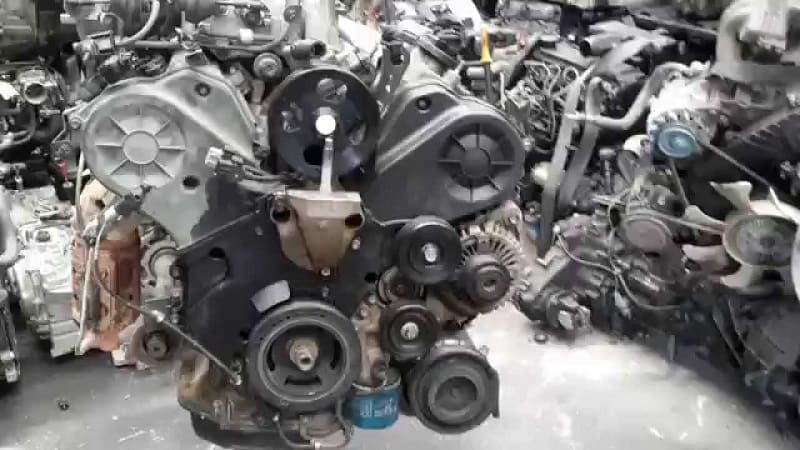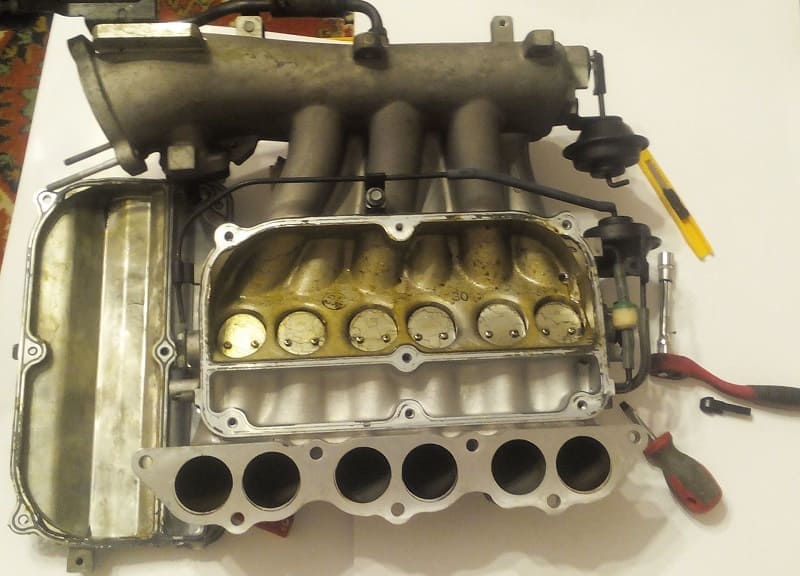
Hyundai G6EA engine
Content
The 2,7-liter power unit of the Hyundai Delta Mu series was released in 2006. For 5 years in a row, it was installed on the cars of the concern, until 2011. This motor differed from the predecessors of the Delta family by the presence of a phase regulator at the inlet. An analogue of this internal combustion engine is also known under the symbol L6EA, but with less power.
Detailed view of the engine

An injection power system, the ability to develop power up to 200 horses, a timing belt drive are the main characteristics of this motor. Of the features, one can single out the presence of VLM and VIS systems, as well as an inlet phase regulator.
The base of the cylinder block is aluminum alloy. The ignition and fuel injection system is electronically controlled. If you take care of the engine in a timely manner, then its resource will be at least 400 thousand kilometers.
| Exact volume | 2656 cm³ |
| Supply system | injector |
| Internal combustion engine power | 180 - 200 HP |
| Torque | 240 - 260 Nm |
| Cylinder block | aluminum V6 |
| Block head | aluminum 24v |
| Bore | 86.7 mm |
| Piston stroke | 75 mm |
| Compression ratio | 16.01.1900 |
| Features of the internal combustion engine | VLM and VIS |
| Timing drive | belt |
| Phase regulator | inlet CVVT |
| Turbocharging | no |
| What kind of oil to pour | 4.8 liters 5W-30 |
| fuel type | gasoline AI-92 |
| Environmental class | EURO 3/4 |
| Approximate resource | 300 000 km |
| Fuel consumption on the example of Kia Magentis 2009 with automatic transmission | 13 liters (city), 6.8 liters (highway), 9.1 liters (combined) |
| What cars was installed on | Santa Fe CM 2006 – 2010, Grandeur TG 2006 – 2011; Magentis MG 2006 – 2010, Carens UN 2006 – 2010, Carnival VQ 2007 – 2011, Cadenza VG 2010 – 2011, Opirus 2009 – |
What cars was installed on
This motor was installed on the following Kia / Hyundai models:
- Santa Fe;
- Grander;
- Magentis;
- Carnival;
- Oprius;
- Karens;
- Cadenza.

Disadvantages, weak areas
The most typical malfunctions of this internal combustion engine are listed below.
- Swirl flaps are often unscrewed and enter the combustion chamber.
- The valves bend the pistons due to a broken timing belt.
- Increased fuel consumption due to worn piston rings.
- The speed floats due to idle speed sensor glitches or a clogged throttle.
Loosening dampers or tryndets motor

When starting this engine, a distinct knocking sound may begin, which will disappear after warming up. It is rare that any of the auto mechanics is able to immediately determine the cause of this behavior. This situation is familiar to many owners of Korean cars - the noise increases with the onset of cold weather.
There can be several possible reasons for this error:
- knock of valves;
- camshaft knock;
- internal engine noise, etc.
However, there is no need to guess in this case, since the noise really increases in winter, and no longer disappears with warming up. After removing both cylinder heads, the reason will immediately be visible - damage to several pistons due to the ingress of parts of the dampers. The edges of the pistons are bent from the impact, and they begin to knock. In addition, the formation of scoring on the walls of the cylinders is possible.
The work in this case is reduced to the following procedures:
- block boring;
- replacement of pistons and rings;
- replacement of gaskets and seals;
- replacement of bearings;
- installing a new timing kit:
- pump replacement;
- replacing camshaft sensors.
In a word, the engine should be brought to a completely new condition. If you carry out work in a service center, you will have to fork out for an amount of about 60 thousand rubles. For lovers of everything original, the amount of repairs will increase by 2-3 times, since up to 120 thousand rubles can be spent on spare parts alone.
Thus, the swirl flaps of this internal combustion engine do him a disservice. They are installed in the intake manifold - there are 6 of them, each is screwed with two small bolts. From vibration, already after 70 thousand kilometers, they can unscrew and get inside the engine. Many call this a constructive blunder of the manufacturer, since this problem of mass order occurs in many.
The price of the Hyundai G6EA motor is about 500 thousand rubles - this is on order from abroad, and you will have to wait at least 6 months. A used version in good condition is much cheaper - from 50 thousand rubles. About 20 thousand will have to be paid for the rearrangement, and also for a new timing kit and pump. So, it is much more profitable to repair the native engine, you get a new unit that will travel another 70 thousand km without any problems.
Ceramic dust that enters the combustion chambers due to the destruction of the catalyst can also lead to grinding of piston rings. This will also lead to the formation of knocks.
G6EA problem on HBO

The car is hard to start when cold. After taking an oscillogram, a terrible picture pops up on one of the coils. As a rule, this happens with engines running on HBO. Therefore, when checking, it is necessary first of all to disconnect the equipment from the nozzles in order to eliminate the problem of gas fuel. Then measure the compression - within 9 bar, this is the norm.
First of all, such signs should entail checks of the following nature:
- whether there is air leakage;
- whether the fuel-air mixture is poor at the twentieth;
- whether the valves are stuck due to gas operation.
If everything is in order with these moments, you need to pay attention to one feature of the G6EA engine, namely, the presence of a CVVT system on the intake camshafts. If the car runs on HBO, be sure to check where the inlet tie-ins are made. It has been proven in practice that many installers do not waste time on such a "trifle", trying to quickly install equipment without removing the intake manifold. This leads to a characteristic problem of this unit - a deep manifold always contributes to valve burnout due to improper gas supply.
The second reason that often pops up in practice is a worn gasket in the gearbox. It is easy to check - a vacuum fitting is installed on the gearbox, from which you need to throw off the hose and coat it with soapy water. If it inflates, then it needs to be replaced.
| Those | I want to ask knowledgeable people, what is the difference between our G6BA and G6EA with Santa Fe in 189 forces? The volumes are the same ... |
| Nikita | The diameter and stroke of the piston is the same, most likely it's in the ECU |
| Arzu | Mechanically, they differ in that the G6EA has a generator in front. Resp. rear air conditioning compressor. Technically, it seems to differ only in the presence of CVVT, respectively. brains are also different. |
| Vasyatka | it turns out a variable timing phase + brains adds 17 forces and a little torque. |
| Chuck Norris | about interchangeability, if anything, it's hard to say. I'm not sure that without serious enough alterations, at least in the lines of the air conditioning compressor and in the electrician, it will be possible to replace. Yes, the engine mounts are different. |
| Elchin76 | Has anyone put the G6EA engine in Sonya? I have Magentis 2,5. Engine overhaul will be needed soon. I figured it would be cheaper to buy a used engine. And if you put another engine, then why not try something more powerful? There are people who know the difference between G6EA and G6BA honey? can one be made into another? what is required for this? all opinions and suggestions are welcome |
| Arzu | yes it is possible. procedure for converting g6ba to g6ea: 1. remove g6ba 2. install g6ea. Replace incompatible parts. Something like this |
| Mikel | Gasoline engine G6EA-2.7L-MU stopped starting on Carney-III 2008. After a run of 100 thousand km, the Check (P2189) periodically began to light up - a lean working mixture at idle (bank 2) - a long-term fuel correction reached 25%, which increased fuel consumption by about 2 liters per 100 km. Engine operation on H.X. was quite stable, but small interruptions were still felt. The official verdict is no big deal. A possible cause is air leakage in the intake tract or problems with the catalyst. I sinned on candles, which I have never changed (according to the regulations, they go up to 120 thousand km) or on an oxygen sensor. After a run of 120 thousand km, the internal combustion engine cooling pump flowed, which on this engine sits on the same timing belt, which was changed at 90 thousand, but the pump was not replaced then, because. supposedly if there is no leakage and backlash, then it is changed through one replacement of the timing. As a result, at 130 thousand, when replacing the pump, the timing also had to be changed. For the money, it turns out that it is much cheaper to change the pump along with the belt, even if it is not leaking yet. After replacing the pump and timing belt, the car drove normally for two days (while it was relatively warm). After a two-day downtime (Saturday, Sunday) on the street, at night temperatures of -20, -25 * C, the engine started up, but there were obvious interruptions in the operation of at least one or two cylinders. Diagnostics showed interruptions in the sparking of the 2nd and 4th cylinders and an oxygen sensor error P0131. After removing the errors, normal engine operation was restored, but after 20-30 km the same errors were repeated again, or rather, P0131 was repeated, and there were interruptions in sparking on one or the other head. Since in the previous two days, after replacing the timing belt, everything was normal, I again began to blame the spark plugs, or poor contact in sensors or lambdas, or gasoline, although I only fill up at proven gas stations, but even an old woman can have a leak. Therefore, I decided to refuel in the British and, just in case, fill in the fuel flush (if it was spark plugs or gasoline, it would help) and drive 100-120 km. But the engine never recovered; after the reset, errors appeared again. We checked the timing belt - everything is in order. Further, according to the servicemen, the problem was to restore the correct relative position of the camshafts on the timing belt side (where there are marks) and on the chain side (where there are no marks), which they somehow did, but the effect is the same - no compression on one head (1,2, 3, and XNUMX cylinders). The engine seems to start, running on one head - it shows an error in the crankshaft sensor... |
| Dormidon | The chains set the camshafts in motion through the mechanisms of phase change, maybe this knob (mechanical phase change) has broken, so there is no compression, there is also a chain tensioner. And did the comrades experts open the covers of the chains? |
| Mikel | Yes, there are some bugs out there. You can see them when you remove the valve cover. I just don't understand how the tensioner works. They say that it is hydraulic - when oil pressure appears, it kind of tightens the chain. Then it turns out that the problem is not on the side where the chain hangs (when there is no pressure), but on the other side, where it is stretched without pressure. But that head seems to work fine. Probably this tensioner, after all, is not hydraulic, but on a spring, and it should tension the chain already in its original state. In the PDF-ke on the G6EA, it’s not a damn thing how it is fixed, you have to look at the engine. But in the picture, the chain does not seem to sag. By the way, there should still be marks on the chains and on the phase change mechanism, probably they just didn’t look for them well. As I understand it, now you need to replace the tensioner, on the side where there is sagging, just in case, replace the phase change mechanism, then first set the marks on the chains, and only then on the timing belt? |
| Craftsman | The marks on the sprockets should be, in the form of drills (recesses), stand at 9 and 3 o'clock relative to each other, on the chain 2 links differ from the others, they are also opposite, when installed, they must be combined with the marks on the sprockets. The tensioner is automatic, if there is any doubt about its performance, it must be replaced, and probably both. Check the blank called the phase regulator for backlash and signs of wear, if there are such parts in the engine, it is recommended to fill in 520 oil in general (Toyota has one), but no one pours it, so it’s not a panacea, but it’s still not necessary very thick. Just in case, you don’t need to change the phase regulator, although it won’t be worse, though it has a price tag like that of a vertical take-off aircraft. There is an opinion that it would be better and cheaper to contact a service with experience in such work, for example, to Anton Vitalyevich. So that later the topic of lapping valves would not be opened, repair of saddles, etc. |

